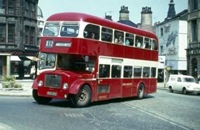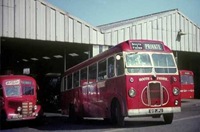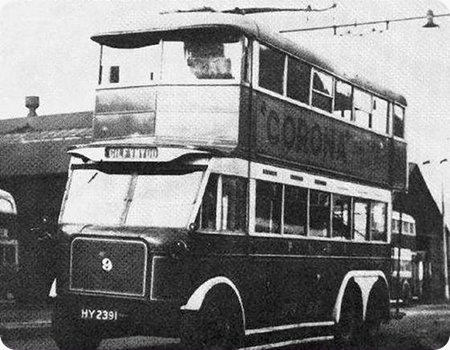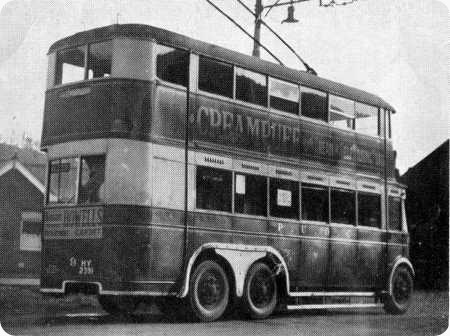
Copyright Roger Cox
North Western Road Car
1961
Dennis Loline III
Alexander H39/32F
This picture, taken on a Saturday in the summer of 1966, shows Dennis Loline III No 892 of North Western turning from Commercial Street into George Street, Halifax, on its trans Pennine X12 run from Bradford to Manchester. Double deckers were often used on Saturdays on this service, and the Loline was easily the most appropriate decker for the purpose in the North Western fleet at the time. I never saw an AEC Renown on this service, and I doubt that, with its four speed gearbox and high ratio rear axle (reputedly giving a 48 mph maximum speed – almost as fast as a Loline) it would have been very suited, though they might have been used. However, the Loline, with its exceptional stability, 6LX engine and five speed gearbox, was ideal for the job. I took several trips across to Manchester on these buses, and they were fine performers on this taxing route. Later that year, on leaving Halifax, I drove the 6LW powered versions of the Loline for Aldershot & District, and found them to be most impressive buses. Had Dennis been more consistent in marketing the Loline – it was forever being withdrawn from their catalogue and then subsequently reinstated, North Western might never have taken the Renown, though BET central purchasing policies might have been the ultimate decider.
Photograph and Copy contributed by Roger Cox
02/06/11 – 05:59
Lovely photograph Roger. As a lifelong fan of Bristol products, I also had a soft spot for the Dennis Loline – being in effect a Lodekka built under licence for the open market. I must admit to preferring East Lancashire or Northern Counties bodywork on the Loline, as Alexander’s ‘balloon roof’ style, although not unattractive, appeared somewhat top heavy to many. That said, the nicely proportioned North Western livery did its best to distract the eye, and it is interesting to note from the photo that the company had specified sliding doors rather than jack knife ones. The Northern Counties-bodied Loline IIIs purchased by Halifax JOC looked particularly attractive in that undertaking’s green, cream and orange livery. Some of the last Loline III’s (including the Halifax ones) had Bristol rear axles, with some even sporting Bristol scrolls on the hubs, but whether the Halifax vehicles had the latter feature I do not know. Dennis did seem a little inconsistent to say the least with their marketing, as you state Roger. Mind you there was also added low-height competition from AEC’s Bridgemaster and Renown, plus the Albion/Leyland Lowlander around the time the Loline was trying to establish itself, which may have had a bearing on things.
Brendan Smith
03/06/11 – 07:29
I agree with your comments, Brendan. The Loline I was a very close copy of the Lodekka – I believe that the Loline displayed at the 1956 Commercial Show was, in fact, a Lodekka with cosmetic alterations by Dennis. The genuine Loline I did have Dennis clutch, gearbox and front axle, and full air braking system – the Lodekka had air/hydraulic brakes – and the mechanically very similar Loline II, which had a forward entrance, appeared before the FLF/FSF Lodekka, though it is probable that Dennis and Bristol shared their design ideas on the concept. The Loline III, which generally had a Dennis rear axle, was much more of a Dennis design, and, having driven conventional transmission Lolines I and III, and LD and FLF Lodekkas, I found the Loline III to have been the nicest of them all. In particular, the Dennis five speed gearbox was very light and easy to use, and the gear positions followed the gate format popularised by the AEC Reliance – R and 1 at the far left and protected by a detente spring (the Reliance had a ledge and the gearstick had to be lifted) then 2,3,4 and 5 in a straightforward H pattern. The Lodekka gearbox was heavier to use, and had 1,2,3 and 4 in the H pattern, and 5 could be engaged only through 4 by moving the gear lever to the right and then forward. If one’s progress was baulked for any reason whilst in fifth, then one had to wrestle the lever back through fourth to reach neutral and the other gears. Whereas 5th was treated as a normal cruising speed even on town work with the Loline, Lodekka drivers seldom went above 4th except where the open road beckoned. The Loline I also had 1,2,3 and 4 in the H pattern, and 5th was engaged by moving the gear lever forward to neutral and then to the right and back again in a U movement. This did enable neutral to be reached directly from fifth. The Halifax Lolines did have Bristol rear axles and were so marked on the hubs. Sadly, I had left my job in the Traffic Office at HPTD Skircoat Road in 1966, and those Lolines arrived the following year, so I never got a chance to drive these fine semi auto machines. By that time I was driving the Aldershot & District examples, all of which had sliding passenger doors. I have a number of other Loline pictures which I will submit in due course. As you have pointed out, the operator’s livery could transform the appearance of a bus body. When Aldershot and District was merged with Thames Valley, the initial overall maroon livery of Alder Valley made the Alexander and Weymann Orion bodies look truly awful. As for the standard NBC livery…………!!!!!
Roger Cox
03/06/11 – 17:10
I agree entirely with your view on the advantages of a sympathetic livery Roger. The much maligned appearance of the MCW Orion and siblings – which incidentally I always liked as clean, smart and functional – was made to look positively immaculate by the Bradford City Transport blue and cream scheme.
I’ve found out much of interest from this Loline topic – I’ve always laboured under the misapprehension that the Loline differed little other than in badging and engine etc from the Lodekka – one’s never too old to learn !!
Chris Youhill
03/06/11 – 17:34
At the risk of being boring, I couldn’t agree more with the positive comments on the Loline, Chris’s comments on the Orion and the general comments on livery and its effects on the looks of a vehicle. It was good that the Lodekka was available outside BTC in this form. (Sheffield’s Orions didn’t look bad either.)
I have to say, though, that I still prefer the Renown – but then I would say that, wouldn’t I? [I regularly rode both down the Oxford and Palatine Roads in Manchester as a student.]
David Oldfield
08/06/11 – 09:50
Reading Corporation had three batches of Dennis Loline IIIs, arriving in autumn 62, summer 64 and late 66/early 67. They carried handsome East Lancs bodywork and had derated Gardner 6LX engines. The first batch had Dennis-built 4-speed gearbox, which seemed to challenge some of the Corpo drivers, cosseted as they were by the nice forgiving gearboxes fitted to the Regent II and IIIs and the Crossleys. A missed gear gave forth not so much a crunch as a resounding clang, often heard when engaging second from rest—something that made me wonder whether they had no clutch-stop. All hubs bore the Dennis name.
The later batches had a Bristol plate on the rear hubs only, and a Bristol 5-speed gearbox with 5th blanked off! Yet even without the potential for extra fuel-saving that a live 5th would have afforded, the Lolines managed over 13 mpg in this fairly hilly town. A few years back I had a drive of 76, a preserved survivor of the last batch (now with 5th UNblocked) and it was a real delight. The first two batches were withdrawn after only 12 years’ service: I hate to think how many excellent vehicle countrywide were swept off the road by the abolition of conductors!
In Classic Bus No 22 (April-May 1996) Gavin Booth and Stephen Morris compare a Renown, a Loline and a Lodekka. With all due respect to David O and all AEC enthusiasts, the Dennis Loline acquits itself very well.
Ian Thompson
08/06/2011 09:52
What excellent liveries we used to have in BET days. Fleets had a real sense of identity. There were a number of Red and Cream BET fleets but there were subtle differences in colour and layout between three contiguous BET Companies – North Western, PMT and Trent. Each was appealing in its own way. Sadly we lost it all in the Corporate blandness of NBC and as for today’s "liveries" – well the less said the better. No identity – just Multi National imposition.
Ian Wild
09/06/11 – 08:29
Not offended, Ian T, I’m sure it did acquit itself very well. I know no-one with half a brain who would denigrate either the Lodekka or the Loline.
…..not to mention Yorkshire Traction.
David Oldfield
13/03/12 – 06:09
I read that Dennis only went looking for bus orders when their other lines were having a lean time in sales, much preferring fire engines and other things than building buses. Also, as with Daimler, they took Cummins when Gardner were hard to come by and that cost them so much it effectively made them give up on commercial vehicles. Daimler took a big hit too with the Roadliner. If only, Cummins had made a better engine or Gardner had better supply! I read the comment of Mr Hilditch, GM of Halifax where he found Dennis to be the best engineered product he had come across.
John (tee)
30/11/12 – 13:21
Following up Ian Thompson’s comment above of 08/06/11, my experiences of driving the Reading buses he mentions were slightly different. I found the Regent III box less forgiving than he suggests, but it was at least consistent, so you only had yourself to blame if you got it wrong. The Dennis 4-speed boxes were far more forgiving; the gears more or less found themselves and you could almost forget about the clutch. As Ian surmises, they had no clutch stop, but there was no excuse for clashing the gears when pulling away. The options were straightforward. If you were only making a short stop, you simply dropped the stick into 2nd as you came to a stand. If you had to stop in neutral, it only required a bit of patience to drop the clutch and wait a bit; ideally you anticipated the conductor’s bell. You were never going to get a racing start anyway, as the accelerator pedal was fitted with a mechanical interlock which only released once the doors had closed. The Bristol box did have a clutch stop, and for someone like myself with long legs it was all too easy to depress the clutch a bit too far and then you really were in trouble. These buses were never so well liked as the earlier batch, as the lack of the 5th gear significantly reduced the top speed – 35mph at best compared with the over 40mph of the earlier ones.
Alan Murray-Rust
30/11/12 – 17:39
Alan, I agree entirely with your assessment of the relative merits of the Dennis and Bristol gearboxes. I didn’t drive the Reading Lolines, but I had extensive experience of the Aldershot and District Mark 1 and Mark III machines, and also occasionally drove Bristol FLFs. The A&D Lolines had Dennis five speed gearboxes, without clutch stops, and they were, without doubt, the finest constant mesh boxes that I have ever handled. They responded to a light touch – you could engage gear cleanly with the pressure of two fingers on the gear lever – and any crunching noises were a testament to sloppy driving practice, not engineering deficiency. The Bristol box was heavier and stiffer in its lever action, making neat engagement of gears more difficult to accomplish. The four speed Dennis box, coupled with the Dennis axle, had properly spaced ratios for a decent top speed in fourth. The five speed boxes, Dennis and Bristol, gave a top speed of around 30 mph in fourth (direct) gear, and the overdrive fifth brought top speed up to around 50 mph. Thus, a Bristol five speed gearbox with the overdrive blanked off would have limited road speed to 30 mph. I have commented above that, because of the gate layout and ease of using the Dennis five speed box, Loline drivers used fifth gear as a normal cruising ratio. The fifth gear on the Bristol was engaged in a contorted "dog leg" action through fourth, and getting the gearstick back into neutral and the other gears could be something of a struggle if the bus was baulked for any reason. In practice, Lodekka drivers only used fifth when faced with a clear, open road, and generally never went above fourth in urban settings. The Loline III was much more than a licence built Lodekka. It was a rather nicer machine in many respects. I cannot understand why Reading specified Bristol gearboxes and axles on its 1964 Lolines. Aldershot was taking Loline deliveries at the same time, and these had Dennis units throughout. Later, when Loline production was drawing down, the Dennis company used Bristol transmission components instead of manufacturing penny numbers of its own axles/gearboxes (the Halifax Lolines had Bristol rear axles also). This would explain the use of Bristol components in the last batch of 1966, but not in the 1964 buses. The small Dennis company had high engineering standards. As an example, the O4/O6 engines were the only British production diesels to have four valves per cylinder, and they incorporated timing gears at the back of the block and wet cylinder liners, all achieved in a powerful, entirely trouble free design. Other engine manufacturers who tried to incorporate such features didn’t entirely succeed.
Roger Cox
20/10/13 – 07:26
Very interesting reading, folks. Thanks so much for the good information. I do have a question, though, and one which I have been totally unable to resolve.
Was the sliding door on the Loline manually operated, or was it powered? I travelled on Lolines in Liverpool (Crosville), but cannot remember if the door opened automatically, or had to be opened by hand.
Terry Hill, Ottawa
20/10/13 – 11:08
Terry, the doors on these buses were air pressure operated, usually by the driver, but the conductor had a control to use if required. I drove the Aldershot & District Alexander bodied Lolines which, apart from having the 6LW engine instead of the 6LX, and 68 rather than 71 seats, were otherwise identical. Fine buses!
Roger Cox
20/10/13 – 11:09
The doors were powered. On North Western’s batches they all gave trouble sticking from time to time and sometimes wouldn’t close when climbing a steep hill, especially in later life. The main problem with them as time went on, particularly with the North Western Alexander bodied batch, was the door would start from open and, as long as the vehicle was on a relatively flat road or heading down hill, would accelerate hitting the front door post with a loud bang instead of travelling at a constant pace and slowing as it reached the closed position as the manufacturer had intended.
Considering the short distance the door had to travel the noise and the eventual damage caused was quite spectacular. The door, the door post and the mechanism all deteriorated, the results being sticking doors, damage to the frame around the door post, distorted doors and at least one instance of a door falling off as related by Peter Caunt in his book North Western – A Drivers Reminiscences.
In fact to quote him on the speed of the doors makes the point:
"This does not really describe adequately the speed at which the door closed or the terror that it inspired in those around it. What happened was the door would be open and the driver would move the lever to the closed position. For a couple of seconds nothing would happen then the door would close like lightning and would knock the hell out of the front corner pillar of the bodywork….when the door was opened it often moved sedately and correctly as though trying to inspire passengers with its genteel behaviour. The fact that it almost pushed the front off the bus when it closed is neither here nor there."
Phil Blinkhorn
20/10/13 – 17:09
Phil, the doors on the Aldershot Lolines would sometimes hit the front door pillar with a bit of a bump, but nothing worse, and (pre NBC) booking this off as a defect always got the thing sorted out. The system was designed to cushion the closing and opening action at a point just short of the end of the door travel, and the last part of the motion was completed at very slow speed. The problems you mention must have arisen from sloppy maintenance or shortage of spares or over tight engineering budgets, or a combination of all three (welcome to the world of the present day big groups).
Roger Cox
20/10/13 – 18:07
The ex Ribble Burlingham bodied PD3s at Southend suffered from the same symptoms as mentioned above. The crews referred to them as Bacon Slicers.
Philip Carlton
21/10/13 – 07:13
Crosville did not operate Lolines in Liverpool, unless an odd ex-North Western Road Car example slipped in under the radar from Warrington.
Crosville (in Liverpool) operated lots of Bristol Lodekkas (FSF & FLF) with front 4-leaf powered doors and lots of Bristol Lodekkas (LD and FS) with rear 2-leaf manual doors.
Dave Farrier
21/10/13 – 17:45
Could be from Warrington. I travelled regularly between Liverpool and Prescot. That route was served by both Crosville and Liverpool Corporation Passenger Transport. LCPT buses, which were unheated at that time, were known on the route as "Corpy ice-boxes"; it was worth the extra couple of pennies to ride on a heated bus in the Winter!
Thank you, gentlemen, one and all, for your information (and your anecdotes). My Dennis Loline is actually a 1/76 scale model, and is an exhibit in my fictitious "Heathersfield Rail/Road Museum" which I am developing as part of an "00" gauge model railway layout. I am currently writing an extensive catalogue of exhibits, and I want to make sure that the information contained therein is as accurate as I can make it (as a retired technical writer, I’m a bit obsessive about accuracy).
My model (made by Britbus) is in SELNEC Southern livery, has fleet number 889 and the licence plate number is RDB 889. If anyone has any information specific to this bus (the real one!), technical, historic or anecdotal, I would be very interested to hear about it.
Terry Hill
29/10/13 – 13:22
Terry, a picture of RDB 889 may be found here:- www.flickr.com/photos/1 A very sad looking ex NWRCC Loline after disposal by Crosville is shown here:- www.flickr.com/photos/2
Roger Cox
30/10/13 – 17:26
Loline RDB 889 had chassis number 1019L3AF2B1 and Alexander body number 6681. It was one of those equipped with the five speed gearbox and was delivered to North Western in December 1961.
Roger Cox
 Vehicle reminder shot for this posting
Vehicle reminder shot for this posting
28/07/17 – 16:31
I know this subject is a few years old now but I have only just found your interesting website, I drove both types of Lolines at Reading and agree with Alan Murray-Rust about the 4 speed Lolines being easier to change gear than the 5 speed version. If you didn’t engage 2nd gear as soon as you stopped at a bus stop it was hard to engage after idling in neutral. They were confined to the busy 15 and 25 routes when I drove them which were converted to OMO a few years later using brand new Scalia Metropolitans which were like Rolls Royces after the Lolines.
Ray Hunt
 Vehicle reminder shot for this posting
Vehicle reminder shot for this posting




